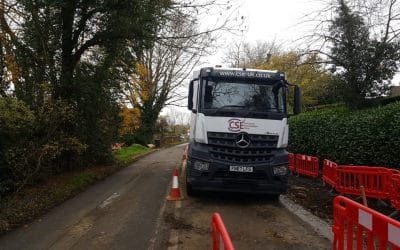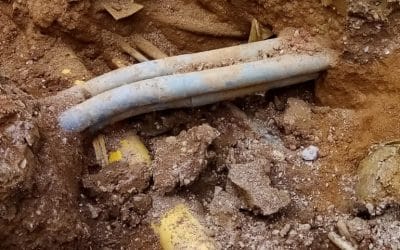Frequently Asked Questions
What are the benefits of vacuum excavation?
Vacuum excavation offers several key benefits. Firstly, it allows for faster and more efficient digging compared to traditional methods. Secondly, it is a safer approach as it minimises the risk of damaging underground utilities or infrastructure. Thirdly, it is non-destructive, preserving the surrounding environment and minimising disruption. Additionally, vacuum excavation provides precise control over excavation, allowing for targeted and accurate digging. Overall, it offers a combination of speed, safety, precision, and minimal environmental impact, making it an advantageous choice for various construction and utility projects.
When is vacuum excavation necessary?
Vacuum excavation is necessary in various scenarios. It is particularly useful when working near sensitive underground utilities like gas, water, or fibre optic lines, where precision and safety are paramount. It is also employed in congested urban areas with limited access, where traditional excavation methods may cause disruption. Vacuum excavation is beneficial during archaeological excavations, as it allows for delicate soil removal without damaging artefacts. Additionally, it is utilised for potholing, trenching, and slot trenching applications, ensuring accurate and controlled digging while minimising the risk of utility damage.
What types of materials can be excavated using vacuum excavation?
It can effectively remove soil, sand, gravel, and clay, making it suitable for a wide range of construction and utility projects. Its ability to handle diverse materials makes it a valuable tool in different industries, offering efficient and precise excavation capabilities for various project requirements.
What is the difference between hydro excavation and air excavation?
The main difference between hydro excavation and air excavation lies in the method used to break up and remove the material. Hydro excavation relies on pressurised water to break up the soil or debris, which is then simultaneously suctioned out by the vacuum. On the other hand, air excavation utilises compressed air to displace and remove the material.
What is potholing, and why is it important?
Potholing is a technique used to precisely locate underground utilities or verify their depth and position. It involves using vacuum excavation to create small, non-destructive holes in the ground. These holes allow visual inspection of the utilities, enabling accurate mapping and identification. Potholing is crucial for preventing utility damage during construction or excavation projects. It helps reduce the risk of accidents, utility service disruptions, and costly repairs. By providing a clear understanding of the underground infrastructure, potholing enhances safety, project planning, and overall efficiency.
How does vacuum excavation compare to traditional excavation methods?
Vacuum excavation offers several advantages over traditional excavation methods. Unlike traditional digging techniques that involve heavy machinery and manual labour, vacuum excavation utilises suction and high-pressure water or air to safely and precisely excavate soil and debris. Vacuum excavation is also non-destructive, preserving the surrounding environment. Additionally, it allows for faster and more efficient digging, especially in congested areas. Overall, vacuum excavation offers a safer, more precise, and efficient alternative to traditional excavation methods.
How much does vacuum excavation cost?
The cost of vacuum excavation varies depending on factors such as project size, location, soil conditions, and duration. Generally, it involves equipment rental, labour costs, disposal fees, and any additional expenses like permits or site preparation. It’s best to consult with a vacuum excavation service provider to obtain an accurate cost estimate tailored to your specific project requirements.
What are the limitations of vacuum excavation?
While vacuum excavation offers numerous benefits, it does have limitations. It may face challenges in hard or rocky soils that require alternative excavation methods. Additionally, extremely deep excavations may exceed the capabilities of standard vacuum excavation equipment. Access restrictions, such as confined spaces or difficult terrain, can also pose limitations. Consulting with professionals can help determine the feasibility of vacuum excavation for your specific project.
What are the environmental impacts of vacuum excavation?
Vacuum excavation has minimal environmental impacts compared to traditional excavation methods. It reduces soil disturbance, minimising damage to vegetation and tree roots. By precisely targeting the excavation area, it helps protect underground utilities, preventing accidental damage and associated environmental issues. Additionally, vacuum excavation minimises the amount of material to be disposed of, reducing waste generation and promoting environmental sustainability. The excavated soil can also be used to refill once the job is done.
How deep can vacuum excavation go?
The depth capabilities of vacuum excavation depend on the specific equipment used. Standard vacuum excavation systems can typically dig to depths of up to 20-feet. However, specialised equipment, such as high-pressure units or extended-reach vacuum excavators, may enable deeper excavations.It’s essential to consult with a vacuum excavation service provider to determine the equipment options available for achieving the desired depth for your project. Contact the friendly and helpful team at CSE today to get started!
Can vacuum excavation be used in areas with limited access?
Yes, vacuum excavation is well-suited for areas with limited access. The equipment’s compact size and extended hoses allow it to reach challenging or confined spaces, such as narrow alleyways, urban environments, or areas with limited manoeuvrability. This makes vacuum excavation an efficient and effective solution for projects where traditional excavation methods may be impractical or disruptive due to restricted access.
How long does a typical vacuum excavation project take?
The duration of a vacuum excavation project depends on various factors, including the project’s complexity, size, soil conditions, and the number of utility lines involved. Smaller projects requiring a few potholes or utility verifications can be completed within a few hours, while larger projects with extensive excavations may take several days. For an initial discussion about your excavation project, simply call the helpful and experienced team at 0118 332 0002 or email at info@cse-uk.co.uk.
Can vacuum excavation be used in cold weather conditions?
Vacuum excavation can be used in cold weather conditions, but certain considerations apply. To find out more about your specific project requirement, simply call experienced vacuum excavation professionals at 0118 332 0002.
What are the regulations and permits required for vacuum excavation?
The regulations and permits required for vacuum excavation may vary based on the specific location and project requirements. Generally, it’s important to comply with local laws, utility notification processes, and obtain any necessary permits or clearances before commencing excavation work. Consulting with local authorities, utility companies, or vacuum excavation specialists can help ensure compliance with the relevant regulations and obtain the required permits. Read more here.
Can vacuum excavation be used for large-scale projects?
Yes, vacuum excavation can be used for large-scale projects. It offers the flexibility to handle both small and large excavation tasks effectively. With proper planning, equipment selection, and skilled operators, vacuum excavation can efficiently and safely tackle large-scale projects, such as major utility installations, pipeline constructions, or infrastructure developments. Call 0118 332 0002 today for more details.
What are the risks associated with vacuum excavation?
While vacuum excavation is generally considered a safe method, there are inherent risks associated with the process. These include potential damage to underground utilities if not properly located or if the equipment is misused. Unforeseen hazards, such as unidentified or poorly marked utility lines, may also pose risks during the excavation process. Proper training, adherence to safety protocols, and comprehensive utility surveys can help mitigate these risks and ensure a safe vacuum excavation operation.
Can vacuum excavation be used for residential projects?
Yes, vacuum excavation can be used for residential projects. It is an effective method for tasks like potholing, trenching, or utility verifications in residential areas. The non-destructive nature of vacuum excavation minimises disruption to yards, gardens, or driveways. It also reduces the risk of damaging utility lines during home improvement projects or repairs. Vacuum excavation is a reliable and efficient choice for various residential applications, offering accurate and safe excavation services while preserving the integrity of the property.
What are some common applications of vacuum excavation in vacuum excavation?
Vacuum excavation has diverse applications. It is commonly used for utility location, potholing, trenching, slot trenching, and daylighting. These applications enable precise and non-destructive digging, reducing the risk of utility damage and ensuring accurate installation or maintenance of utility lines. Vacuum excavation’s versatility makes it valuable in industries such as construction, telecommunications, utilities, and infrastructure development. Its ability to safely and efficiently expose underground infrastructure makes it an essential tool in various excavation projects.
Recent Projects
Sean Takes on The Ring of Kerry!
Our Director, Sean, has decided to take on the challenge of cycling The Ring of Kerry this July! This iconic cycling event, now in its 42nd year, takes place along one of the world’s most famous touring routes - The Ring of Kerry. The route spans a...
Vacuum Excavation Case Study: Culvert Excavation
When one of our customers in Cornwall was in need of excavating an old culvert that had been lying dormant for many years, they required a quick solution to remove any built-up material. Throughout the years, ground material had been building up within...
Vacuum Excavation Case Study: Underground Utilities
Safe excavation methods are vastly becoming an essential process on construction sites as well as new builds and so, our team have taken a closer look at the process in more detail… Importance of Utility Detection Before contractors begin to break the...



